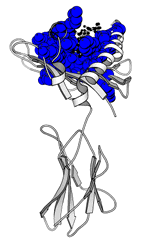Call For Papers, Posters, and Demonstrations
Topics in Call For Papers
|
Background
|
Organizers
|
Submission Information
Proteins: Structure, Function and Evolution
Pacific Symposium on Biocomputing 2002
January 3-7, 2002
Kauai Marriott Resort and Beach Club
Pacific Symposium on Biocomputing 2002
January 3-7, 2002
Kauai Marriott Resort and Beach Club

Background
Problems related with the protein structure determination problem have dominated work in computational biology, from the very inception of this field. New computational advances, such as that currently underway with IBM's Blue Gene supercomputer (projected completion in 2005), as well as advances in the understanding of energy potentials and development of statistical methods for recognition of specific folds or protein classes, together promise better methods for protein structure prediction. Indeed, we have recently witnessed enormous progress in the field of protein folding, including successful approaches to computational structure prediction as documented in recent CASP competitions.
On a different front, advances in evolutionary genomics have led to efforts to mine the evolutionary history of proteins, in order to better understand the structure and function of proteins. Indeed, in developing methods for optimal extraction of structure and functional prediction from multiple sequences, there is a growing realization that proper evolutionary analysis is an essential component. Extensions of neutral evolution theory have led to the development of more complex models for the adaptive landscape of protein mutation and selection, leading to interactive efforts, where model predictions of computational biologists can be tested in the laboratory by molecular biologists.
The prediction of protein structure has been a major focus of biophysical research over the last two decades, There is a growing realization that the historical information, the sequence diversity available in databanks, is extremely useful in solving the protein folding problem. Even neural network methods perform better when multiple and diverse sequences are included in the analysis. The patterns of variation and conservation throughout a homologous sequence set provide signals indicating the underlying shared structure. Analyzing the presence of co-evolving sites in proteins is beginning to make important contributions to the solution as analytical methods improve, as are more refined estimates of the tendencies of different secondary structures and hydrophobic environments to have different substitution rates. Sophisticated methods for detecting amino acid residues under diversifying selective pressure across closely related species are generating interesting hypotheses about the structure and function of the protein, which can be tested in the laboratory. The methods and accuracy of phylogenetic inference have also been improving, and with that has come a better understanding of the effect of phylogenetic inference (and sequence alignment) on inferences of substitutional and coevolutionary patterns. We now have the ability to recreate ancestral proteins, and thus test general trends in protein function and hypothetical correlated functional relationships. In vitro evolution, both random and directed, can attempt to replicate the historical patterns, and further elucidate the details of the adaptive landscape.
Topics in the CALL FOR PAPERS
- Protein modeling using homology and molecular dynamics -- an applications area attempting to explain dysfunctional proteins, obtained by pointwise mutagenesis experiments.
- Statistical algorithms for recognition of structural protein motifs. Derivation of Quasi-potential energy functions for folding and binding, ab intio Molecular Mechanics Methods, Knowledge-based database statistics methods based on quasichemical approximation (pioneered by Miyazawa and Jernigan), optimization methods (perceptron, Z-score optimization).
- Protein threading - models and algorithms, ab initio Protein Structure Prediction, Simulation in simplified on- and off-lattice models, All-atom simulations, Fragment assembly methods, hierrachical methods, Protein Docking, Novel applications of Constraint Programming, Monte-Carlo and Genetic Algorithms in protein folding.
- Datamining and Functional Genomics in protein evolutionary history, Phylogenetic inference and sequence alignment as it concerns substitutional and coevolutionary patterns in amino acid sequences, Position-dependent substitution matrices.
-
Development of metric and non-metric recombination spaces with
new graph theoretic tools towards modeling the assembly of proteins
from a "finite parts list",
Determination of evolutionary relationships between proteins by
comparison across all proteins in a genome and across multiple
divergent genomes.
Organizers
The organizers are P. Clote, G. Naylor, E. Shakhnovich and Z. Yang. You can contact each of the organizers below for more details.-
Peter Clote
Department of Computer Science and Department of Biology
Boston College
Chestnut Hill, MA 02467, USA
Peter Clote -
Gavin Naylor
Department of Zoology and Genetics
Iowa State University
Ames, Iowa 50011, USA
Gavin Naylor -
Eugene Shakhnovich
Department of Chemistry and Chemical Biology
Harvard University
12 Oxford Street
Cambridge, MA 02138, USA
Eugene Shakhnovich -
Ziheng Yang
Galton Laboratory Department of Biology
University College London
4 Stephenson Way
London NW1 2HE, England
Ziheng Yang
Submission Information
| Submissions are due: | 16 July 2001 |
| Decisions are announced: | 20 August 2001 |
| Camera ready copy due: | 24 September 2001 |
| Poster abstracts due: | 5 November 2001 |
| Further general information | http://psb.stanford.edu |
All papers must be submitted to russ.altman@stanford.edu in electronic format. The file formats we accept are: postscript (*.ps), adobe acrobat (*.pdf) and Microsoft Word documents (*.doc). Attached files should be named with the last name of the first author (e.g. altman.ps, altman.pdf, or altman.doc).
Hardcopy submissions or unprocessed TEX or LATEX files will be rejected without review.
Each paper must be accompanied by a cover letter. The cover letter must state the following:
- The email address of the corresponding author
- The specific PSB session that should review the paper or abstract
- The submitted paper contains original, unpublished results, and is not currently under consideration elsewhere.
- All co-authors concur with the contents of the paper.
Submitted papers are limited to twelve (12) pages in our publication format. Please format your paper according to instructions found at ftp://ftp-smi.stanford.edu/pub/altman/psb. If figures can not be easily resised and placed precisely in the text, then it should be clear that with appropriate modifications, the total manuscript length would be within the page limit.